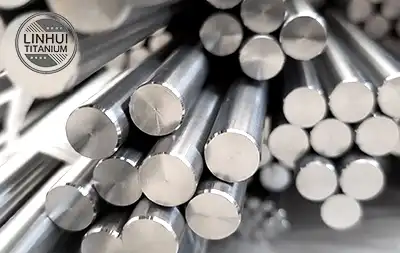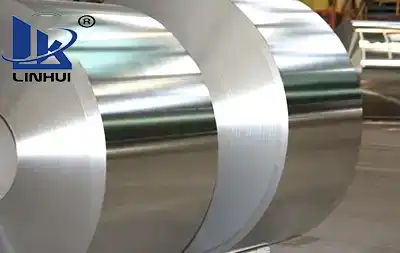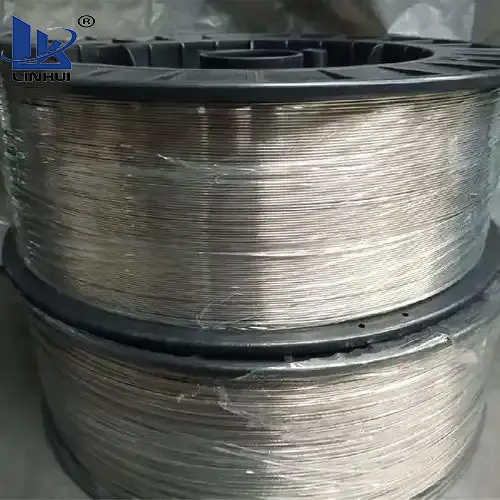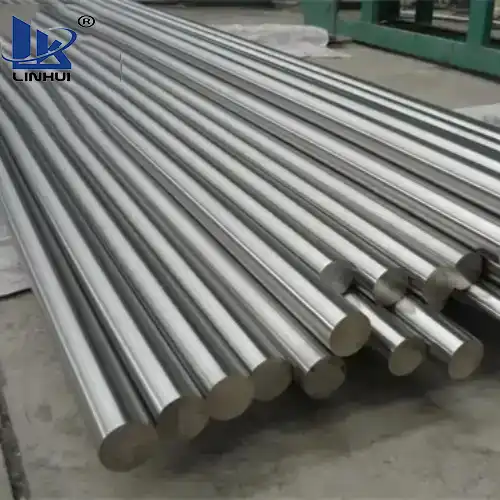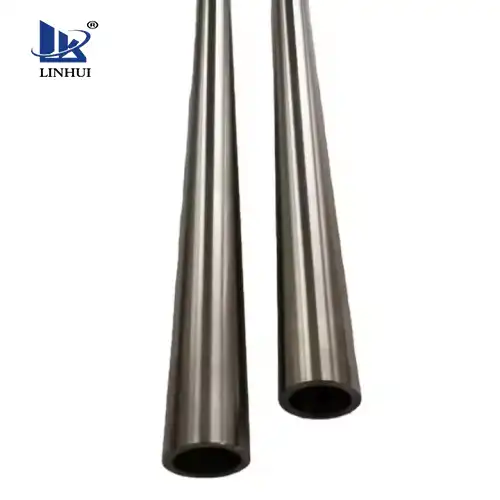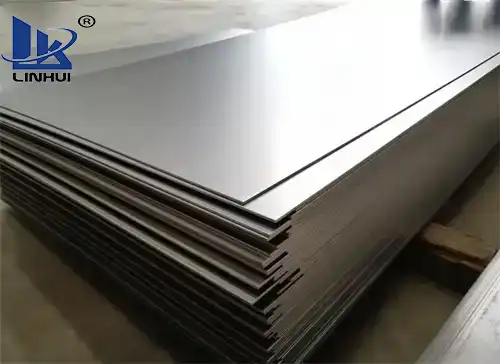During production, it was found that common defects in the surface quality of titanium alloy machining include excessive corrosion, dust hanging, incomplete removal of oxide scale, and striped spots.
1. Over corrosion
Over-corrosion refers to the appearance of pits or uneven unevenness on the surface of titanium alloy after pickling, which is different from the material structure. Generally, the cause of over-corrosion defects is the imbalance of the proportion of hydrofluoric acid and nitric acid, and the concentration of hydrofluoric acid is too high. insufficient nitric acid concentration can cause this defect. Another reason is that the pickling time is too long. Generally, the pickling is 1 mm to 4 minutes. The process parameters can be adjusted according to the operation site to shorten the pickling time appropriately.
2. Hang ashes
Ash refers to the oxides attached to the surface of the titanium alloy after pickling. During pickling, the dry titanium alloy and the acid undergo a chemical reaction. The resulting oxides accumulate on the surface, preventing further reactions from occurring. The defects of hanging ash are generally: Caused by excessive ash deposition during pickling and insufficient rinsing after pickling. During pickling, the parts should be shaken continuously to make the reaction products fall off the surface of the titanium alloy. After pickling, spraying or rinsing should be strengthened to remove hanging dust. In China, high-speed water flow mixed with compressed air and tap water is generally used to flush parts, and the effect is good.
3. The oxide scale has not been completely removed
There are many reasons for this defect, and it is possible in every process. There may be poor degreasing, insufficient molten salt treatment time, or an ineffective pickling solution. When this defect occurs, various possible factors should be eliminated one by one. If necessary, a sandblasting process can be added to the pre-treatment.
4. Striped piebald
The cause of this defect is generally due to uneven reaction. This can be eliminated by shaking the parts during pickling and lowering the temperature of the pickling solution. In addition to the above defects, sometimes it is found that after some time, spots appear on the surface of products that have passed the inspection after pickling. There are relatively few studies on this phenomenon. It may be due to the presence of residual acid on the surface after pickling or the presence of corrosive media brought in by subsequent production. It is produced under the combined action of stress. Under microscopic examination, it is different from the general corrosion form. The difference generally does not affect its performance and can be removed by pickling again. However, the stress-bearing parts must be strengthened with hydrogen removal treatment after the second pickling.
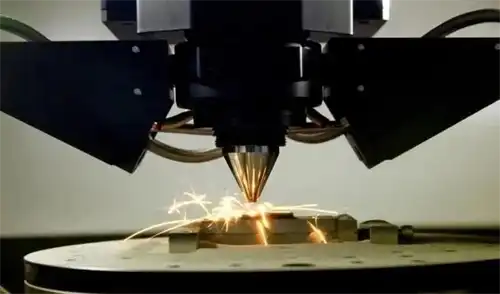
What are the factors that affect the machining performance of titanium alloys?
Thermal conductivity, elastic modulus, chemical activity, alloy type, and microstructure are the main factors affecting the machining performance of titanium alloys. The thermal conductivity of titanium alloy is small, about 1/3 of iron, and the heat generated during mechanical processing is difficult to release through the workpiece; at the same time, because titanium alloy has a small specific heat, the local temperature rises quickly during processing. It is easy to cause the tool temperature to be very high, causing sharp wear of the tooltip and reducing the service life. Experiments have shown that the temperature of the tool front when cutting titanium alloy is 2-3 times higher than that of cutting steel.
The elastic modulus of titanium alloy is low, which makes the machined surface easy to spring back. Especially the processing springback of thin-walled parts is more serious, which can easily cause strong friction between the flank surface and the machined surface, thereby wearing out the tool and chipping. Titanium alloys are very chemically active and can easily interact with oxygen, hydrogen, and nitrogen at high temperatures, causing their hardness to increase and their plasticity to decrease. It is difficult to machine the oxygen-rich layer formed during heating and forging. The alloy composition of titanium alloys is different, and their processing properties are also different. In the annealed state, a-type titanium alloys have better machining properties; a+β-type titanium alloys follow; β-type titanium alloys have high strength and good hardenability. But the machining performance is the worst.
Because of the above situation, to perform high-efficiency and high-precision machining of titanium alloys, corresponding measures should be taken to avoid the occurrence of defects during processing.
Research on various mechanical processing of titanium alloys
There are many methods for machining titanium alloys, including turning, milling, boring, drilling, grinding, tapping, sawing, EDM, etc.
1. Turning and boring of titanium alloy
The main problems of turning titanium alloy are high cutting temperature; severe tool wear; and large cutting spring back. Under suitable machining conditions. Turning and boring are not particularly difficult operations. For continuous cutting, mass production, or cutting with large amounts of metal removal, carbide tools are generally used. When forming cutting, grooving, or cutting off, adjusted steel tools are suitable, and cermet tools are also used. As with other machining operations, always use constant forced feed to avoid cutting interruptions. Do not stop or slow down during cutting. Generally, cutting should not be carried out, but sufficient cooling should be carried out; the coolant can be 5% sodium nitrate aqueous solution or 1/20 soluble oil emulsion aqueous solution. Before forging, use carbide tools to turn the oxygen-rich layer on the surface of the original bar. The cutting depth should be greater than the thickness of the oxygen-rich layer. The cutting speed is 20~30m/min, and the feed rate is 0.1~0.2mm/r. Boring is a finishing process, especially for thin-walled titanium alloy products. During the boring process, burns and clamping deformation of parts should be prevented.
2. Drilling of titanium alloy
When drilling titanium alloy, it is easy to generate long and thin curled chips. At the same time, the drilling heat is high, which easily causes the chips to accumulate excessively or adhere to the drilling edge. This is the main reason for the difficulty in drilling titanium alloy. Drilling should use a short and sharp drill bit and low-speed forced feed. The support bracket should be tightened and given repeated and sufficient cooling, especially for deep-hole drilling. During the drilling process, the drill bit should remain in the drilling state in the hole and should not be allowed to idle in the hole, and the drilling speed should be maintained at a low and constant speed. Be careful when drilling through holes. When you are about to drill through, clean the drill bit and drilled hole and remove drill chips, it is best to return the drill bit and use forced feed when the hole is finally broken, so that a smooth hole can be obtained.
3. Tapping of titanium alloy
Tapping titanium alloys is probably the most difficult machining process. When tapping, the limited removal of titanium chips and the severe tendency to bite will lead to poor thread fit, causing the tap to get stuck or break. When tapping is complete, the titanium alloy tends to dry out and tighten on the tap. Therefore, we should try to avoid processing blind holes or overly long through holes to prevent the surface roughness of the internal thread from becoming larger or the phenomenon of broken cones. At the same time, the tapping method should be continuously improved, for example, the trailing edge of the tap can be ground away. An axial chip groove, etc. is ground on the tooth top along the length of the tooth edge. On the other hand, taps with oxidized, oxidized, or chromium-plated surfaces are used to reduce bite and wear.
4. Sawing processing of titanium alloy
When sawing titanium alloys, use low surface speeds and continuous forced feed. Experiments have shown that coarse-toothed high-speed steel saw blades with a tooth pitch of 4.2mm to 8.5mm are suitable for sawing titanium alloys. If a band saw is used to saw titanium alloy, the tooth pitch of the saw blade is determined by the thickness of the workpiece, generally 2.5mm ~ 25.4mm. The thicker the material, the larger the tooth pitch. Force feed capability and required coolant must be maintained at the same time.
5. EDM processing of titanium alloy
EDM machining of titanium alloys requires an operating gap between the tool and the workpiece. The best gap range is 0.005mm0.4mm. Smaller gaps are often used for finishing that requires smooth surfaces, while larger gaps are used for roughing that requires rapid metal removal. The best electrode materials are copper and zinc.
Through the above analysis and research, the reasons for the failure of titanium alloy machined surface quality were obtained, and various methods in the processing process were analyzed, thereby finding practical ways to solve the problem of titanium alloy machined surface quality.






